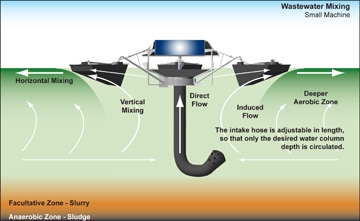'Thumbs Up' For Michigan's Peninsula: Wastewater Treatment Plant Meets Phosphorous Discharge Numbers With Help From SolarBee Mixer

Long-distance circulation technology improves distribution of oxygen, algae, bacteria and nutrients while also dispersing ferric chloride.
The “thumb” of Michigan, outlined by Saginaw Bay and Lake Huron, is a peninsula rich in lakes, rivers and streams. Given the ecologically sensitive territory, smaller towns with limited resources can find it challenging to meet state-mandated wastewater discharge permit levels. The village of North Branch, pop. 1,035, about 30 miles northeast of Flint, faced problems of too-high phosphorous in its four-pond facultative system. To find out how to combat the problem and meet state discharge permit levels, wastewater treatment plant operator Ron Seaman got on the Internet. Online searching helps him solve most of the plant’s issues, and after diligent research, Seaman learned that SolarBee solar-powered mixers from Medora Corporation, Dickinson, N.D., could meet his requirements — and provide additional bonuses — without over-taxing the village’s budget.
Located near the north branch of the Flint River (which empties into Saginaw Bay), the village is primarily residential, with a few small factories and relatively little agriculture. North Branch’s permit level for phosphorous discharge is 1.0 milligrams per liter (mg/L), which is normal for the state but “stringent,” Seaman said, for the village. Prior to installing SolarBee circulators, the plant’s phosphorous discharge levels were between 2.0 and 4.0 mg/L. Seaman thinks the high phosphorous count could be because of naturally occurring levels in the water, or maybe laundry detergent. Detergent phosphorous is regulated, but not banned, in Michigan. “I can tell when it’s washday,” said Seaman. “The pond is full of bubbles.” Regardless of the cause of the problem, Seaman no longer has trouble complying with phosphorous discharge levels, thanks to the SolarBee mixers he has installed in the plant’s first two ponds.
Seaman purchased his first SolarBee mixer both to mix the water and disperse ferric chloride in pond 2 (which has a surface area of 4.2 acres, a maximum depth of 12 feet, a 10-million-gallon volume and an average daily flow of 0.03 million gallons). A chemical injection pump on shore pumps the chemical to the SolarBee mixer, which spreads the chemical throughout the pond. Injecting chemical at the machine is the fastest way to disperse it through the lagoon. Seaman initially considered dispersing chemical from a boat, but rejected the idea as too time-consuming and cumbersome.
 Meanwhile, the mixer’s long-distance circulation technology soon brought the pond to within discharge permit levels. In a facultative pond, the mixer creates a horizontal and vertical pattern that improves distribution of oxygen, algae, bacteria and nutrients. During the day, supersaturated oxygen in the top two feet is captured and mixed deeper into the pond. At night, when the surface is below saturation oxygen, surface re-aeration occurs, and atmospheric oxygen is mixed into the pond
Meanwhile, the mixer’s long-distance circulation technology soon brought the pond to within discharge permit levels. In a facultative pond, the mixer creates a horizontal and vertical pattern that improves distribution of oxygen, algae, bacteria and nutrients. During the day, supersaturated oxygen in the top two feet is captured and mixed deeper into the pond. At night, when the surface is below saturation oxygen, surface re-aeration occurs, and atmospheric oxygen is mixed into the pond
Following this success, Seaman purchased a second mixer for pond 1 (which has a surface area of 1.3 acres and a 3.5 MG volume) to enhance ammonia and phosphorous reductions and eliminate short-circuiting. For over three years, phosphorous concentrations have remained below 1.0 mg/L, so Seaman has not needed further applications of ferric chloride. In fact, the circulators are helping to further reduce biochemical oxygen demand (BOD), from a high of 49 mg/L before the circulators were installed to an average of 14 mg/L BOD when discharged.
“The main thing that the SolarBee units do now is keep sewage blended and the dissolved oxygen numbers up,” Seaman said. “I honestly believe that, for the dollars, this is one of the cheapest treatment processes you can put in your lagoon. Maintenance is almost zero, and if we do have a problem, anytime I have called them, [SolarBee representatives] always get right back to me.” Helping to keep Michigan’s peninsula streams clean is a thumbs-up for Seaman and the village of North Branch.
About Medora Corporation
GridBee and SolarBee are brands of Medora Corporation, Dickinson, North Dakota, a leader in scientific and engineered methods for improving water quality. For more information, visit www.medoraco.com.
About SolarBee, a brand of Medora Corporation
SolarBee long-distance circulators and mixers help solve difficult problems in wastewater treatment. SolarBee’s award-winning and patented long-distance circulation (LDC) technology has been successfully applied to reduce aeration mixing horsepower by over 60 percent, thus reducing energy usage and cost. Long-distance circulators can also provide process improvements and odor control solutions in equalization ponds, anaerobic ponds and high-waste industrial ponds. LDC has been proven in hundreds of applications worldwide, and solutions are available in both solar-powered and grid-connected options. For more information, visit www.medoraco.com.
Source: SolarBee
